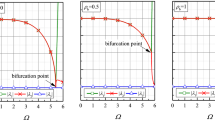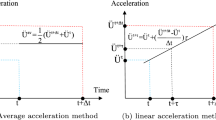Abstract
This paper proposes a two-sub-step time integration method with controllable dissipation to solve nonlinear dynamic problems. The proposed method has second-order accuracy, unconditional stability and zero-order overshoots. In addition, different from most existing time integration methods, the present method is self-starting, and initial acceleration vector is not required. Importantly, the well-known BN-stability theory for first-order nonlinear dynamics is employed to design algorithmic parameters; thus, the present method is BN-stable, or unconditionally stable for nonlinear dynamics. The present method can give stable and accurate predictions for nonlinear problems in which some excellent methods such as the trapezoidal rule and the ρ∞-Bathe method fail. A few representative nonlinear numerical examples show that the proposed method enjoys advantages in accuracy, stability and energy conservation compared with the trapezoidal rule and the ρ∞-Bathe method.





















Similar content being viewed by others
Data availability statement
Data sharing is not applicable to this article as no datasets were generated or analyzed during the current study.
References
Bathe, K.J.: Finite Element Procedures. Prentice Hall, Upper Saddle River (1996)
Chung, J., Hulbert, G.M.: A time integration algorithm for structural dynamics with improved numerical dissipation: the Generalized-α method. J. Appl. Mech. 60(2), 371–375 (1993)
Shao, H.P., Cai, C.W.: A three parameters algorithm for numerical integration of structural dynamic equations. Chin. J. Appl. Mech. 5(4), 76–81 (1988)
Wood, W.L., Bossak, M., Zienkiewicz, O.C.: An alpha modification of Newmark’s method. Int. J. Numer. Methods Eng. 15, 1562–1566 (1980)
Hilber, H.M., Hughes, T.J.R., Taylor, R.L.: Improved numerical dissipation for time integration algorithms in structural dynamics. Earthq. Eng. Struct. D. 5, 283–292 (1977)
Zhou, X., Tamma, K.K.: Design, analysis, and synthesis of generalized single step single solve and optimal algorithms for structural dynamics. Int. J. Numer. Methods Eng. 59, 597–668 (2004)
Kennedy, C.A., Carpenter, M.H.: Diagonally implicit Runge-Kutta methods for stiff ODEs. Appl. Numer. Math. 146, 221–244 (2019)
Boom, P.D., Zingg, D.W.: Optimization of high-order diagonally-implicit Runge-Kutta methods. J. Comput. Phys. 1(15), 168–191 (2018)
Butcher, J.C.: Numerical Methods for Ordinary Differential Equations. John Wiley and Sons, Chichester (2016)
Calvo, M., Montijano, J.I., Randez, L.: Constructive characterization of Runge-Kutta methods that satisfy the M-condition. Bol. Soc. Esp. Mat. Apl. 74, 345–359 (2017)
Dong, S.: BDF-like methods for nonlinear dynamic analysis. J. Comput. Phys. 229(8), 3019–3045 (2010)
Gear, C.W.: Numerical Initial Value Problems in Ordinary Differential Equations. Prentice Hall, New Jersey (1971)
Zhang, H.M., Zhang, R.S., Masarati, P.: Improved second-order unconditionally stable schemes of linear multi-step and equivalent single-step integration methdos. Comput. Mech. 67, 289–313 (2021)
Bathe, K.J., Baig, M.M.I.: On a composite implicit time integration procedure for nonlinear dynamics. Comput. Struct. 83, 2513–2534 (2005)
Bathe, K.J.: Conserving energy and momentum in nonlinear dynamics: a simple implicit time integration scheme. Comput. Struct. 85(7–8), 437–445 (2007)
Nilsson, K., Tornberg, F.: On blowdown analysis with efficient and reliable direct time integration methods for wave propagation and fluid-structure-interaction response. Comput. Struct. 216, 1–14 (2019)
Chandra, Y., Zhou, Y., Stanciulescu, I., Eason, T., Spottswood, S.: A robust composite time integration scheme for snap-through problems. Comput. Mech. 55, 1041–1056 (2015)
Wen, W.B., Wei, K., Lei, H.S., Duan, S.Y., Fang, D.N.: A novel sub-step composite implicit time integration scheme for structural dynamics. Comput. Struct. 182, 176–186 (2017)
Xing, Y.F., Ji, Y., Zhang, H.M.: On the construction of a type of composite time integration methods. Comput. Struct. 221, 157–178 (2019)
Zhang, H.M., Xing, Y.F.: Optimization of a class of composite method for structural dynamics. Comput. Struct. 202, 60–73 (2018)
Noh, G., Bathe, K.J.: The Bathe time integration method with controllable spectral radius: the ρ∞-Bathe method. Comput. Struct. 212, 299–310 (2019)
Kim, W., Choi, S.Y.: An improved implicit time integration algorithm: the generalized composite time integration algorithm. Comput. Strcut. 196, 341–354 (2018)
Li, J.Z., Yu, K.P.: A novel family of controllably dissipative composite integration algorithms for structural dynamic analysis. Nonlinear Dyn. 96(4), 2475–2507 (2019)
Ji, Y., Xing, Y.F.: An optimized three-sub-step composite time integration method with controllable numerical dissipation. Comput. Strcut. 231, 106210 (2020)
Zhang, H.M., Zhang, R.S., Xing, Y.F., Masarati, P.: On the optimization of n-sub-step composite time integration methods. Nonlinear Dyn. 102, 1939–1962 (2020)
Kuhl, D., Crisfield, M.A.: Energy-conserving and decaying algorithms in nonlinear structural dynamics. Int. J. Numer. Meth. Engng. 45, 569–599 (1999)
Burrage, K., Butcher, J.C.: Stability criteria for implicit Runge-Kutta methods. SIAM J. Numer. Anal. 16(1), 46–57 (1979)
Burrage, K.: High order algebraically stable Runge-Kutta methods. BIT 18, 373–383 (1978)
Butcher, J.C.: Nonlinear stability of a general class of differential equation methods. BIT 20, 185–203 (1980)
Soares, D.: A model/solution-adaptive explicit-implicit time marching technique for wave propagation analysis. Int. J. Numer. Methods Eng. 119, 590–617 (2019)
Har, J., Tamma, K.K.: Advances in Computational Dynamics of Particles, Materials and Structures. John Wiley & Sons, New York (2012)
Hughes, T.J.R.: The Finite Element Method: Linear Static and Dynamic Finite Element Analysis. Prentice Hall, New Jersey (1987)
Ji, Y., Xing, Y.F.: An improved higher-order time integration algorithm for structural dynamics. CMES-Comp. Model. Eng. 126(2), 519–575 (2021)
Acknowledgements
The support of the National Natural Science Foundation of China (11872090) is gratefully acknowledged.
Author information
Authors and Affiliations
Corresponding author
Ethics declarations
Conflict of interest
The authors declare that they have no conflict of interest.
Additional information
Publisher's Note
Springer Nature remains neutral with regard to jurisdictional claims in published maps and institutional affiliations.
Appendix A: Effective stiffness matrices and load vectors
Appendix A: Effective stiffness matrices and load vectors
The time-stepping equations have the forms as
where the effective stiffness matrices are
and the load vectors are
Rights and permissions
About this article
Cite this article
Ji, Y., Xing, Y. & Wiercigroch, M. An unconditionally stable time integration method with controllable dissipation for second-order nonlinear dynamics. Nonlinear Dyn 105, 3341–3358 (2021). https://doi.org/10.1007/s11071-021-06720-9
Received:
Accepted:
Published:
Issue Date:
DOI: https://doi.org/10.1007/s11071-021-06720-9




